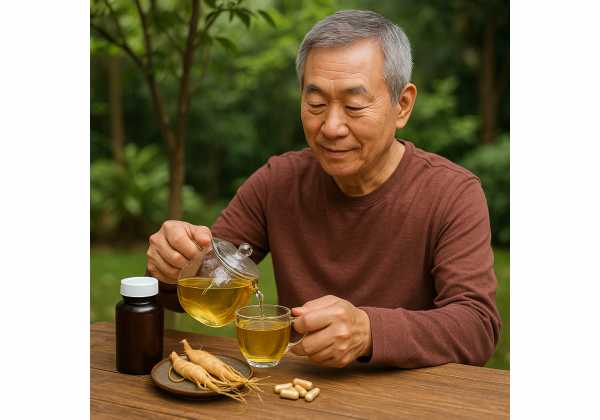CoQ10 for Longevity: Ubiquinol and Ubiquinone and Cellular Energy
Aging changes how our cells make and use energy. Mitochondria—the tiny power plants inside cells—must keep electrons moving cleanly along the respiratory chain. Coenzyme Q10 (CoQ10) sits at the center of that process, shuttling electrons, buffering oxidative stress, and helping tissues with high energy demands, like the heart and skeletal muscle. Circulating CoQ10 levels tend to fall with age...
Creatine for Healthy Aging: Muscle, Brain, and Safety
Aging reshapes how we produce and use energy. That shift shows up in everyday life: climbing stairs, remembering names, recovering after a walk or workout. Creatine sits at the center of cellular energy transfer, buffering ATP where and when tissues need it most—especially in fast-twitch muscle fibers and energetically demanding brain regions. Thoughtful supplementation can narrow age-related gaps in...
Curcumin for Healthy Aging: Inflammation and Bioavailability
Curcumin—the principal polyphenol in turmeric—sits at the intersection of diet, inflammation, and longevity science. It targets immune pathways involved in “inflammaging,” the low-grade, chronic inflammation that rises with age and contributes to joint degeneration, metabolic drift, and cognitive decline. Yet curcumin’s promise is tempered by poor oral absorption and rapid metabolism, which is why delivery form matters as much...
DHEA Supplementation in Aging: Endocrine Context, Benefits, and Cautions
Dehydroepiandrosterone (DHEA) sits upstream of testosterone and estrogens and declines steadily from early adulthood. That quiet drop can intersect with age-related changes in strength, mood, libido, and body composition. Yet DHEA is not a simple “hormone booster.” It behaves as a precursor that tissues convert locally, and outcomes vary by sex, age, dose, and health status. This guide explains...
EGCG for Healthy Aging: Green Tea Extract and Cardiometabolic Health
Epigallocatechin gallate (EGCG) is the best-studied catechin in green tea. It sits at the crossroads of metabolism, vascular biology, and cellular defense. Observational and clinical data point to modest improvements in weight control, lipid balance, and endothelial function when EGCG is used thoughtfully. At the same time, dose and formulation matter: supplements can deliver high catechin loads quickly, which...
Fisetin for Healthy Aging: A Practical Guide to Senolytic Use
Fisetin is a plant-derived flavonol that drew attention when researchers observed it could help clear damaged “senescent” cells in animal models. Senescent cells stop dividing yet persist; they release inflammatory signals that can drive tissue wear, metabolic drift, and frailty with age. The promise of fisetin—and senolytics more broadly—is to reduce that burden in short, intermittent pulses rather than...
Ginseng for Healthy Aging: Energy, Immunity, and Evidence
Aging well is not just about adding years—it is about preserving energy, attention, and resilience. Among botanical options, ginseng has a long record in traditional medicine and a growing modern evidence base. Research explores how ginseng’s ginsenosides influence stress responses, inflammation, and cellular energy systems, with outcomes measured in fatigue, cognition, immune function, and quality of life. Yet results...
Glucosamine and Longevity: What Observational Studies Suggest
Glucosamine entered public awareness as a joint supplement, but its story has widened. Large population datasets now associate regular use with lower risks for cardiovascular events and all-cause mortality, while clinical trials still focus mainly on osteoarthritis symptoms. Those two threads—observational longevity signals and randomized joint outcomes—do not prove the same thing, yet together they offer a grounded picture...
Glycine for Longevity: Sleep, Collagen, and Metabolic Aging
Glycine is the simplest amino acid, yet it threads through many systems that matter for healthy aging. It helps shape sleep quality, builds collagen-rich tissues, and participates in pathways that influence insulin sensitivity and oxidative stress. Circulating glycine is often lower in people with obesity and diabetes, and small trials suggest evening doses can smooth sleep and next-day alertness....
GlyNAC for Aging: What Human Studies Suggest for Glutathione and Mitochondria
GlyNAC—the combination of glycine and N-acetylcysteine—aims to restore glutathione, the cell’s master antioxidant that declines with age. Over the last few years, small but carefully measured human studies have asked a practical question: if we provide the precursors glycine and cysteine (via NAC), can older adults rebuild glutathione, dial down oxidative stress, and improve mitochondrial function and physical capacity?...
Grape Seed Extract for Healthy Aging: OPCs and Vascular Health
Grape seed extract (GSE) concentrates a family of polyphenols called oligomeric proanthocyanidins (OPCs). Over the past two decades, human trials have explored whether standardized OPC-rich extracts can support vascular function, blood pressure, skin quality, and cognitive measures relevant to healthy aging. The short answer: benefits appear most consistent for select vascular outcomes—especially in people with borderline high blood pressure—while...
Hesperidin and Diosmin for Vascular Aging: Endothelial and Metabolic Support
Citrus bioflavonoids—especially hesperidin and diosmin—are among the best studied “venoactive” nutrients for blood vessel health. They originate in orange and lemon peels (hesperidin) and as a semi-synthetic derivative from hesperidin (diosmin), then are formulated as standardized extracts. Over decades, clinicians have used them to support microcirculation and venous competence, while newer trials explore effects on endothelial function, arterial stiffness,...
HMB for Aging: Muscle Preservation and Strength in Older Adults
Skeletal muscle is a powerful predictor of healthy aging. It shapes mobility, glucose control, resilience after illness, and independence. Among nutritional tools, β-hydroxy-β-methylbutyrate (HMB)—a leucine metabolite—has a focused role: it tempers muscle protein breakdown while supporting synthesis, particularly when physical activity or illness strains recovery. This guide translates human evidence into practical use for older adults and caregivers. You...
Hyaluronic Acid for Skin Aging: Do Oral Supplements Work
Fine lines, dryness, and loss of bounce are visible signs of how the skin changes with age. Hyaluronic acid (HA)—a water-binding molecule found naturally in skin—has become a staple in serums and fillers. But what about oral hyaluronic acid? In recent years, controlled studies have tested capsules and drinks containing HA to see whether they improve hydration, elasticity, and...
Hydroxytyrosol for Longevity: Olive Polyphenols and Mediterranean Aging
Oral olive polyphenols have moved from culinary curiosity to serious candidates for healthy aging. Hydroxytyrosol—the best-studied phenolic from olives—appears to act at the crossroads of oxidative stress, endothelial function, and low-grade inflammation. People often hear that “extra-virgin olive oil is good for you,” but they rarely learn how much of that benefit tracks back to specific compounds and doses....
Inositol for Healthy Aging: Insulin Sensitivity and Metabolic Support
Aging shifts how our cells handle glucose, lipids, and inflammation. Those shifts influence energy, sleep, body composition, and vascular health. Inositol—particularly the myo-inositol and D-chiro-inositol isomers—sits inside key signaling pathways that help cells respond to insulin and other hormones. While inositol is best known in reproductive endocrinology, its reach is wider: metabolic aging, liver fat, lipids, and even sleep...




















